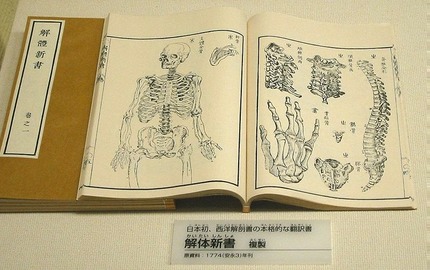Kai tai Shinsho 1874 /Ontleedkundige taferelen 1734/Anatomische Tabellen 1732
During the Sakoku period (1643-1853) Dutch tradesman in Deshima were the only connection between Japan and the Western world. Besides Western goods the Dutch also imported Western knowledge into Japan mainly through books, maps , drawings and and scientific objects. The Japanese were flabbergasted by the exact representation of reality in book illustrations. A Japanese medical doctor who studied a Dutch illustrated anatomical textbook was shocked when he realized that the book illustrations perfectly matched with the cut body at his dissection table. The Japanese soon discovered the enormous impact of western knowledge.
The Japanese Tokugawa government understood that the superior scientific and technological knowledge of the foreigners was based on a different, more objective way of thinking and observing. Modern Western painting was also based on another way of observing reality.That is the reason later on they stimulated the establishment of schools for modern painting. In the minds of most Japanese artists Western realism was a Copernican revolution. A common complaint of them was that they missed the energy or life in the Western illustrations. It was at right angles to their classical education. Moreover they considered the principles of modern painting as a threat of their intellectual and artistic freedom. A few artists embraced modern painting. So a heated debate developed between the adherents of traditional and modern painting. In this debate the painter Shiba Kokan resolutely took position in favour of the new realism.
